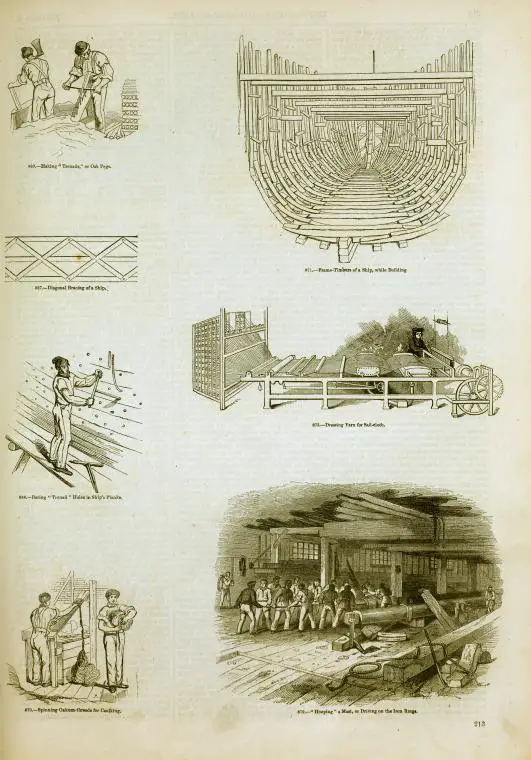Shipbuilding
Shipbuilding was an essential component in Colonial America and quickly grew into one of the growing industries of the young United States. In the colonial period, European nations were the economic powerhouses of the globe.
They significantly influence trade and commerce in both South and North America. While some areas in the colonies were rich in crops, other territories, particularly the ones located in New England, were not conducive to the development of Agriculture.
This was because the areas were susceptible to poor climatic conditions and have poorly developed soils.

Nevertheless, New England had excellent access to the Atlantic Ocean, which subsequently resulted in the development of thriving fishing industry to increase its shipbuilding market further.
The ideal placement of New England and the continuous demand present for water transport indicated that they were involved in the shipping industry as a function of their agricultural impotence, the development of a fishing
industry, and their locations.
On the other hand, east coast settlements in New Hampshire and Philadelphia also provided protected bays and harbors as well as riverbanks and small coves that were suitable for construction. More often than not, shipbuilders during the colonial period made use of raw materials found on dense forests to developed ships.
The first vessels built in the colonies were small craft that was designed to use for fishing and local travel. Sponsors of new territories distributed shipwrights from England to create ships as most colonists did not know anything about ship construction.
Even though most vessels of the early 17th century were miniature, a few larger ships were built to cater to individuals who want to cross the Atlantic. As the colonies expanded, the need for supplies from England and communication with the rest of the empire increased as the ships distributed unique exports to each colony.
Several old building sites rose to popularity, including New Haven and New London in Connecticut, Boston, and Salem in Massachusetts, and Newport, Rhode Island. While shipbuilding in the middle colonies experienced a momentary lag, the English builders were quick to establish the shipbuilding presence in New York City and Philadelphia by 1720.
Merchants in Britain and local ship owners represented an extensive market for colonial vessels. As stated on the Navigations Act of the 17th century, English merchants were only allowed to use American or English-built ships for trade.
By the dusk of the Revolutionary War, the colonial shipbuilding industry had a strong foothold in America. Although values are tough to determine because of the nature of available records, historians have calculated that Americans built at least one-third of British merchant ships at that time.
Fun and Interesting Facts about Shipbuilding in Colonial America
- Americans were selling 18,000 tons of about 40,000 tons of vessel capacity to Britain each year during the colonial period.
- The Shipwright is the individual who drafted the design and instructed the craftsmen while building the ship.
- The city of Philadelphia, New York, and Boston remained the top shipbuilding sites during the period following the Revolution until the 19th century.
- The building of massive shipyards in these cities also prompted some builders like Isaac Webb, Donald McKay, Stephen Smith, Christian Berg, and Henry Eckford to receive nationwide attention for their work.
- While side-wheel steamboats began their operations on the East coast by the 1790s, their use did not become practical until the introduction of the designs made by Robert Fulton in 1807.Ships and vessels became profitable during the colonial period in America as timber grew scarce in England.
- The Colonial era was often considered the golden age of Philadelphia shipbuilding with several shipbuilders developing and designing Atlantic brigantines and fast coastal ships.
- The demand for merchant's vessels, particularly schooners, brigs, sloops, and scows, created a flurry of shipbuilding in the riverfront of Delaware in the early 17th century.
Q & A
Why did ships and vessels become profitable during the colonial period?
Vessels and ships were profitable in the Colonial period because of the lack of Timber
in England.
When was the Golden Age of Philadelphia shipbuilding?
The Golden Age of Philadelphia shipbuilding was in the colonial era.
What kind of ships were developed during the Golden Age of Philadelphia shipbuilding?
Several shipbuilders during the Golden Age of Philadelphia shipbuilding built fast coastal ships and Atlantic Brigantines.
When did the English establish the presence of shipbuilding in Philadelphia and New York City?
The shipbuilding industry was established in New York City and Philadelphia in 1720.
When did side-wheel steamboats become practical?
Side-wheel steamboats became practical in 1807.



